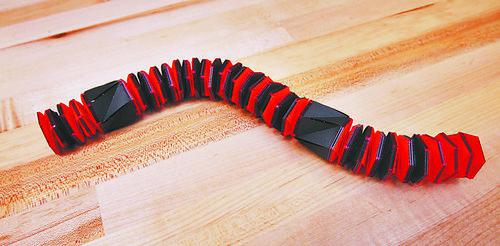

-
Hot resource recommendation -
Popular amplifier recommendation
-
Beihang team has developed a helicopter pilot robot that can independently control flight -
Trader launches Tallysman TW5386 smart GNSS UDR antenna for robot and autonomous precise timing applications -
The era of humanoid robot has come, unlocking the mystery of future intelligence -
In 2030, the market size of humanoid robot electronic skin will reach 9.05 billion! -
Innovation of flexible electronic technology and application prospect of electronic skin of humanoid robot -
Humanoid robots perceive the future of change -
The latest product of Purdue Robot, Hulu Pro, was shortlisted for 2024 Fast Company Innovation Design Award -
Stone Technology sweeping robot adopts the hybrid flight time system of Infineon and Paiande -
[Vico Cup] Yifei Technology participated in the "Vico Cup · OFweek 2023 China Robot Industry Annual Outstanding Enterprise Award"
-
Typical application circuit of BTS 3134 N intelligent low side power switch -
STEVAL-MKI166V1, H3LIS100DL adapter board for standard DIL24 socket -
Typical Application of AM2S-4815SH30Z 15V 2W DC to DC Converter -
Typical Applications of AM2G-2415SH30Z 15V 2W DC-DC Converter for On/Off Control Applications -
Typical Application of Si7051 Si1133 Temperature Sensor -
25W, 21 LED indoor and outdoor LED drivers for street and indoor LED lighting -
Reference design of MIC5375-2.8YMT using Microchip Technology -
[Lichuang Development Board] Nange's game console -
Front wheel drive sub plate (gray+drive+infrared) -
Typical Application of NCP1117 1.0 A Low Voltage Drop Positive Adjustable Regulator
-

Stereo tube power amplifier -

Selective Timer Alarm Circuit Based on IC4060 and IC555 -

How to use PWM generated by Arduino to control the speed of AC fan -

Portable microphone preamplifier circuit with transistor -

0-30V adjustable regulated power supply circuit based on LM317 -

Typical monostable circuit sharing
-
Technical parameters and specifications of tuning fork level switch -
S3c2440 Road to Learning - 001 Assembly lights up led -
Jz2440 bare metal development and analysis: connection of different bit width devices of memory controller 2 -
Some iPhone 13 photos have mosaics. Apple customer service responded that no customer feedback was received -
High performance motor and servo driver control optimization ∑ - Δ modulation current measurement scheme -
Hunting Semiconductor launched 2.5mmX3.5mm global minimum size 4G/5G MMMB PA -
Teach you to measure the core voltage with a multimeter -
Design of Access Control Safety Management System Based on MCU
-
Progress of Tesla 4680 batteries: 50 million in three months -
Can the "Fengma" match made by nature change the global fuel cell pattern? -
Aurix StartKit based on Infineon TC4D9+TLF4D985 -
GEMnet 10 Gigabit differential connector | Tyco Electronics confirms the declaration of 2024 Golden Series Award -
Has the air vent for intelligent vehicle diagnosis arrived? -
Talk about the current situation of intelligent driving from Xiaopeng M03 auto parking car to Audi -
BOE (BOE) and the Palace Museum held the 2024 "Lighting the Growth Road" public welfare project landing ceremony -
When the automobile competition enters the intelligent era, how to choose a more secure and reliable GPU? -
It is Germany's technology that has launched a new revolution: the universal oscilloscope has officially entered the era of 14bit ADC -
Countdown to 5 days! ICDIA-IC Show&AEIF 2024 Ready
-
Free application | Maxim high-performance simulation kit (including 78 devices) -
It is one of the award-winning Q&A activities of Germany Science and Technology. It is an oscilloscope scheme for A4WP wireless charging test. It is a good gift to break through the test! -
NI labview, CompactDAQ technology collection -
Renesa electronic RL78/G14 demo board starts at 19.9 yuan, including postage -
Atelier AT32WB415 series Bluetooth BLE 5.0 MCU, free fresh experience! -
Make suggestions for "ADI laboratory circuit"! -
TI invites you to fill in the questionnaire and win a gift | private customization of your 2019 industrial application scheme -
Help EEWorld 19 grow up and win beautiful gifts! -
Extraordinary Fujitsu FRAM can write data at high speed with only a small power supply! It's polite to watch the video!
-
When will the fast charging market welcome the "triple gun salute"? -
How to Operate Projected TV _ Features of Projected TV -
Sharing of the most popular smart home devices -
Visual Bit Machine completed a round A financing of nearly 100 million yuan to promote the intellectualization of 3D vision software and hardware platform -
Level L4 autonomous driving Robobus is the first in the world and will be put into public transit line operation -
Cambrian Joins Hands with ZTE to Accelerate Edge Intelligence in 5G Era -
Making Rational Use of Roadside Parking Space Startups Launch Parking Space Reservation System -
America tests new technology, beautifying appearance and free vision, and cameras will replace rear-view mirrors -
Significant cost reduction Mahler launched a new modular hybrid drive system -
STM32 development -- UART application layer communication protocol analysis
-
Design and Application of Wireless LED Lighting System -
What kind of sensor is used to detect the real entry and exit -
What is PCB design DSP and detailed explanation of DSP technology -
Project Design: Belt Speed Measurement -
Correct selection and operation maintenance of leakage protection switch -
IiC protocol -
[MSP430 Sharing] The most complete e-book collection -
Why does the Bluetooth module not respond to HCI commands? -
AD sampling of 28335? -
Discussion on the Development Trend of Power Management
















